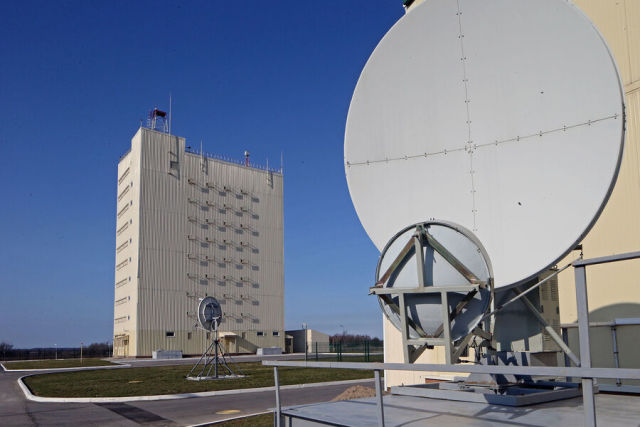Why are new Voronezh missile attack warning stations being built in Russia? Two more Voronezh-type missile attack warning system (SPRN) radar stations will be commissioned in Russia, and two more will be built, the general designer of the SPRN Sergey Boev said at the Army-2022 forum.
Military observer of the Newspaper.En" Mikhail Khodarenok explains why the country needs them - and how the stations will close the gaps left after the collapse of the USSR.
"Construction is underway in the south, construction is underway in the north. At the same time, two new directions are being developed with the installation of radar facilities and complexes - these are the Far East and the Northwest," said Sergey Boev, general designer of the SPRN and CEO of the Vimpel Corporation, without details.
As the newspaper wrote .Ru", with the collapse of the Soviet Union in 1991, the unified Missile Attack Warning System (SPRN) of the state ceased to exist. A significant part of the radio engineering nodes of the SPRN remained on the territory of the newly independent states. With some of them, it was subsequently possible to agree on the use of the SPRN radar. However, for the most part, the radars were either decommissioned or simply blown up, as happened in Latvia.
In order to close the north-eastern sector, in the 1970s and 1980s, the construction of the SPRN radar station in the city of Yeniseisk (Krasnoyarsk Territory) was launched. However, at the request of the American side (under the pretext of violating the 1972 ABM Treaty), the locator was completely destroyed.
Thus, Russia inherited from the USSR a warning system with gaping gaps and not fully ensuring the national security of the state.
RADAR 77YA6 "Voronezh" is a stationary over-the-horizon radar station of the so-called high factory readiness (VZG radar). There are variants of the locator that work in the range of both meter and decimeter /centimeter radio waves. Both have their own set of advantages and disadvantages.
The Voronezh radar station consists of a transceiver installation with an active phased array antenna, a prefabricated building for personnel and several containers with electronic equipment.
The high degree of factory readiness and the modular principle of construction of the Voronezh radar made it possible to abandon capital multi-storey structures and erect a locator within just 12-18 months. It took from 5 to 9 years to build the radar stations of the previous generations of the Daryal and Dnepr types.
Now all Voronezh equipment in container design is delivered from manufacturers for subsequent assembly at pre-concreted sites.
The power consumption of Voronezh is only 0.7 MW. For example, a radar of the Daryal type, deployed in Soviet times in the settlement of Kutkashen in Azerbaijan, consumed 50 MW - a significant part of the capacities of the neighboring Mingechaur hydroelectric power station worked for the power supply of this facility.
Currently, there are several modifications of the Voronezh type radar, almost all developed with the participation of specialists from the A. L. Mints Radio Engineering Institute (part of the RTI Systems concern).
The Voronezh-M radar operates in the meter range of radio waves. The target detection range is up to 6 thousand km. Voronezh-DM operates in the decimeter range of radio waves, the target detection range is up to 6 thousand km horizontally and up to 8 thousand km vertically.
The radar is capable of simultaneously detecting and tracking up to 500 objects.
The Voronezh-VP high-potential radar represents a further development of the Voronezh-M meter range station. The power consumption in this case is up to 10 MW.
Finally, the Voronezh-SM locator operates in the centimeter range of radio waves, and Voronezh-MSM operates in two bands at once - meter and centimeter.
The Voronezh-DM radar is currently deployed in Armavir, Krasnodar Krai, the village of Pionersky, Kaliningrad Oblast, Yeniseisk (Ust-Kem settlement), Barnaul (Konyukhi settlement), Altai Krai and in the city of Zeya, Amur Oblast.
The Voronezh-M radar is currently deployed in the locality of Lekhtusi, Leningrad Region, Orsk, Orenburg Region, the city of Usolye-Sibirskoye (Mishelevka), Irkutsk Region and Vorkuta (Vorgashor), Komi Republic.
In Sevastopol, on Cape Chersonesos, the construction of the radar complex 116ZH6 ("Voronezh-MM-CM-M-DM") is underway. This promising station will operate in four bands at once.
In Olenegorsk, Murmansk region (village Channels) construction of RLK 113ZH6 ("Voronezh-DM-VP") continues. This locator is designed to replace the outdated Dnepr SPRN radar deployed at this position in Soviet times.
There is reason to believe that it was about the last two SPRN radars that General Designer Sergey Boev spoke when he reported - "construction is underway in the south, construction is underway in the north."
In this case, the Russian missile attack warning system will become all-inclusive, and all the gaps that previously existed in it will be completely eliminated.
In other words, the formation of a closed radar warning field about a missile attack will be completed at a new technological level with significantly improved characteristics and capabilities, which even the mighty Soviet Union failed to achieve at the time.
In addition, in accordance with the draft missile attack warning system, in addition to over-the-horizon radars, it should also include a space echelon. It allows you to significantly expand the capabilities of the system due to the ability to detect ballistic missiles almost immediately after launch.
To ensure the solution of the tasks of detecting ballistic missile launches and bringing the Strategic Nuclear Forces (strategic nuclear forces) combat control commands on the basis of the former Soviet systems "Oko" and "Oko-1", a Unified Space System (CES) "Dome" has been deployed in Russia.
In May 2020, the fourth spacecraft of the new generation 14F142 "Tundra" was launched in Russia, designed for early detection of launches of intercontinental ballistic missiles. Flying in highly elliptical orbits, spacecraft of this type constantly monitor areas from which nuclear missile strikes can potentially be launched on the territory of the Russian Federation. The Tundra spacecraft are part of the Unified Dome Space System, which will also include several satellites in geostationary orbit. After the launch of the fourth Tundra spacecraft, the ECC reached the minimum basic configuration.
The restoration of the space echelon of the SPRN is an important event in the field of strengthening the national security of the country. It is on the basis of data from the space and ground echelon of the SPRN that the Supreme Commander-in-Chief decides on a counter-counter (retaliatory) massive nuclear missile strike.
The opinion of the author may not coincide with the position of the editorial board.Biography of the author:
Mikhail Mikhailovich Khodarenok is a military columnist for the newspaper.
Ru", retired colonel.
He graduated from the Minsk Higher Engineering Anti-Aircraft Missile School (1976), the Military Air Defense Command Academy (1986).
Commander of the S-75 anti-aircraft missile division (1980-1983).
Deputy Commander of the anti-aircraft missile regiment (1986-1988).
Senior Officer of the General Staff of the Air Defense Forces (1988-1992).
Officer of the Main Operational Directorate of the General Staff (1992-2000).
Graduated from the Military Academy of the General Staff of the Armed Forces of Russia (1998).
Columnist of "Nezavisimaya Gazeta" (2000-2003), editor-in-chief of the newspaper "Military-Industrial Courier" (2010-2015).Mikhail Khodarenok



